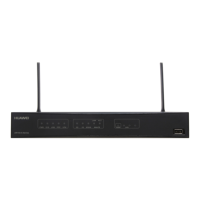info-center loghost 10.1.1.2 facility local2
info-center loghost 10.2.1.1 channel 6 facility local4
info-center loghost 10.2.1.2 channel 6 facility local4
#
interface Ethernet1/0/0
ip address 172.16.0.1 255.255.255.0
#
ip route-static 10.1.1.0 255.255.255.0 172.16.0.2
ip route-static 10.2.1.0 255.255.255.0 172.16.0.2
#
return
2.7.3 Example for Configuring Binary Logs to be Sent to the Log
Host
This section describes how to output logs to the log host in binary mode. Outputting logs in
binary mode can effectively lighten the network load.
Networking Requirements
As shown in Figure 2-6, binary logs generated on Router A are sent to the log host in real time.
Users or maintenance personnel can analyze the log through log analysis tools and locate the
fault.
Figure 2-6 Example for Configuring Binary Logs to be sent to the Log Host
RouterA
Loghost
Eth1/0/0
10.1.1.1/24
10.1.1.6/24
Configuration Roadmap
The configuration roadmap is as follows:
1. Enable the information center on the router.
2. Add the ID of the log to be filtered.
3. Configure binary logs to be sent to the log host.
Data Preparation
To complete the configuration, you need to perform the following data:
l ID of the log to be filtered
l IP address of the FTP server
l User name and password used for logging into the FTP server
l IP address of the log host
Huawei AR150&200 Series Enterprise Routers
Configuration Guide - Device Management 2 Information Center Configuration
Issue 02 (2012-03-30) Huawei Proprietary and Confidential
Copyright © Huawei Technologies Co., Ltd.
41

